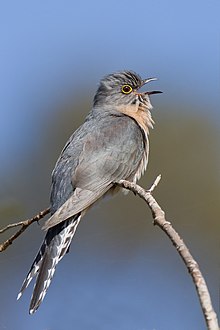
The grey-bellied cuckoo or the Indian plaintive cuckoo is a cuckoo with widespread occurrence throughout Asia.

The anis are the three species of birds in the genus Crotophaga of the cuckoo family. They are essentially tropical New World birds, although the range of two species just reaches the United States.

The banded bay cuckoo or bay-banded cuckoo is a species of small cuckoo found in the Indian subcontinent and Southeast Asia. Like others in the genus they have round nostrils. They are usually founded in well-wooded areas mainly in the lower hills. Males sing from exposed branches during the breeding season, which can vary with region. They are distinctive both in their calls as well as plumage with a white eyebrowed appearance and the rufous upperparts with regular dark bands and the whitish underside with fine striations.
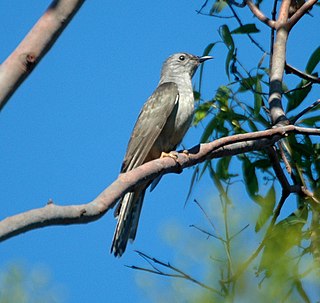
The brush cuckoo is a member of the cuckoo family.
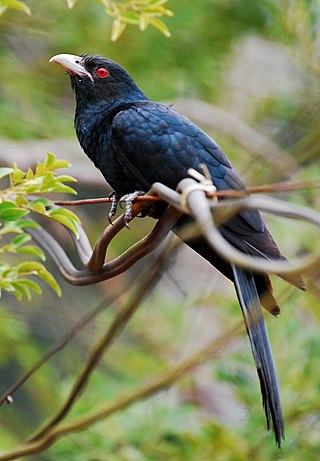
The true koels, Eudynamys, are a genus of cuckoos from Asia, Australia and the Pacific. They are large sexually dimorphic cuckoos that eat fruits and insects and have loud distinctive calls. They are brood parasites, laying their eggs in the nests of other species.

Cuculus is a genus of cuckoos which has representatives in most of the Old World, although the greatest diversity is in tropical southern and southeastern Asia.

Coccyzus is a genus of cuckoos which occur in the Americas. The genus name is from Ancient Greek kokkuzo, which means to call like a common cuckoo. The genus includes the lizard cuckoos that were formerly included in the genus Saurothera.

The plaintive cuckoo is a species of bird belonging to the genus Cacomantis in the cuckoo family Cuculidae. It is native to Asia, from India, Nepal and China to Indonesia.

The chestnut-breasted cuckoo is a species of cuckoo in the family Cuculidae. It is found in Australia, Indonesia, and Papua New Guinea. Its natural habitats are subtropical or tropical dry forests and subtropical or tropical mangrove forests.

The fan-tailed cuckoo is a species of cuckoo in the family Cuculidae. It is found in Australia, Fiji, New Caledonia, New Zealand, New Guinea, Solomon Islands, and Vanuatu.

The white-crowned cuckoo or white-crowned koel is a species of cuckoo in the family Cuculidae. It was originally described by Salomon Müller as Cuculus leucolophus. It was later placed in the monotypic genus Caliechthrus, but most taxonomists place it the genus Cacomantis because it has a similar song to other cuckoos in this genus and it is genetically similar to the pallid cuckoo. It is found in New Guinea and neighbouring Salawati Island.
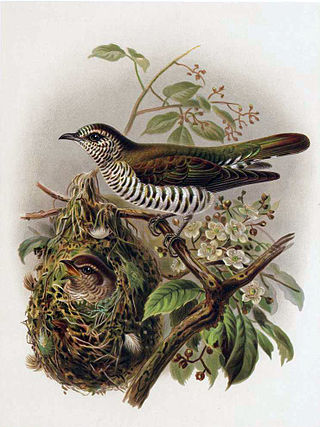
Chrysococcyx is a genus of cuckoo in the family Cuculidae.

The Asian emerald cuckoo is a species of cuckoo in the family Cuculidae. It is found in Bangladesh, Bhutan, Cambodia, China, India, Indonesia, Laos, Malaysia, Myanmar, Nepal, Sri Lanka, Thailand, and Vietnam. Its natural habitats are subtropical or tropical moist lowland forests and subtropical or tropical moist montane forest.

The pallid cuckoo is a species of cuckoo in the family Cuculidae. It is found in Australia, with some migration to the islands of Timor and Papua New Guinea. It is between 28 and 33 cm in size, with distinctive markings such as a dark bill, a dark eye with a gold eye-ring and olive grey feet which differentiate it from other cuckoos. The pallid cuckoo is similar in appearance to the oriental cuckoo, with barred immature pallid cuckoos being often mistaken for oriental cuckoos.
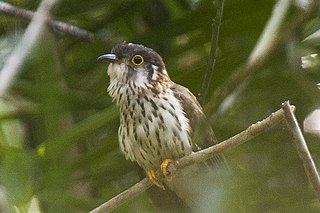
The moustached hawk-cuckoo is a species of cuckoo in the family Cuculidae. It is found in Brunei, Indonesia, Laos, Malaysia, Myanmar, and Thailand. Its natural habitat is evergreen and secondary forests. Threatened by habitat loss, it has been assessed as a near-threatened species.

The chestnut-bellied cuckoo is a species of bird in the tribe Phaenicophaeini, subfamily Cuculinae of the cuckoo family Cuculidae. It is endemic to Jamaica.

The chestnut-breasted malkoha is a species of cuckoo in the family Cuculidae. Found in Southeast Asia from Myanmar through to eastern Java, the Philippines and Borneo, it is a large cuckoo measuring up to 49 cm (19 in) with grey and dark green upperparts and chestnut underparts, and a large curved pale upper mandible. The male and female are similar in plumage. Unlike many cuckoos, it builds its nest and raises its own young.

The red-billed malkoha is a species of cuckoo in the family Cuculidae. It is found in Brunei, Indonesia, Malaysia, Myanmar, and Thailand. Its natural habitat is subtropical or tropical dry forests.
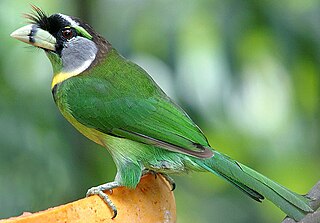
Psilopogon is a genus of Old World barbets that used to include only a single species, the fire-tufted barbet. Results of molecular phylogenetic analyses indicate that the genus is nested within an evolutionary branch consisting of Asian barbets that were formerly placed in the genus Megalaima proposed by George Robert Gray in 1841. Since Psilopogon was proposed by Salomon Müller already in 1835, this name takes priority.

The Sunda cuckoo or Sunda lesser cuckoo is a South-east Asian bird belonging to the genus Cuculus in the cuckoo family, Cuculidae. It was formerly classified with the Himalayan cuckoo and Oriental cuckoo in a single species, C. saturatus, but is now often regarded as a separate species based on differences in voice, size and plumage.
